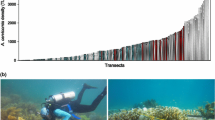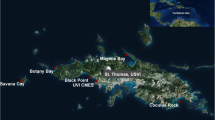Abstract
Several scleractinian coral species with different growth forms and life history strategies were studied in terms of colony growth (expressed as projected linear increment) and survivorship over a range of distances and environmental conditions in the Philippines. The experimental design consisted of 1 m2 plots grouped within a reef site, to several sites within reef systems separated by a distance of about 340 km. There were distinct differences among species, with submassive and massive forms displaying slower growth but better survival, confirming results of other studies. They probably play the role of framework builders of the reef. In contrast, the delicate branching and foliose species had higher growth rates but poor survivorship. This observation, plus their ease of fragmentation, suggests they act more as fillers of the reef matrix. There was high variability in colony increment of a species among the square meter plots, but not among sites within a reef system. Thus, more regular pattern could be observed at this level. In contrast to growth, survivorship differed significantly among sites, being lowest in the site which harbored the greatest amount of dead coral. Growth and survival, however, are not sufficient performance measures to evaluate the success of coral transplantation. Reproduction and subsequent recruitment must also be taken into account. It is recommended that coral transplant and restoration studies consider the broad environmental context of restoration and seek to develop assembly rules that will allow practitioners to match coral types and sequence of interventions to each unique context.




Similar content being viewed by others
References
Anthony KRN (1999) A tank system for studying benthic aquatic organisms at predictable levels of turbidity and sedimentation: case study examining coral growth. Limnol Oceanogr 44:1415–1422
Ayre DJ, Hughes TP (2000) Genotypic diversity and gene flow in brooding and spawning corals along the Great Barrier Reef, Australia. Evolution 54:1590–1605
Bowden-Kerby A (2001) Low-tech coral reef restoration methods modeled after natural fragmentation processes. Bull Mar Sci 69:915–931
Bruno JF (1998) Fragmentation in Madracis mirabilis (Duchassaing and Michelotti): how common is size-specific fragment survivorship in corals? J Exp Mar Biol Ecol 230:169–181
Clark S, Edwards AJ (1995) Coral transplantation as an aid to reef rehabilitation: evaluation of a case study in the Maldives Islands. Coral Reefs 14:201–213
Done TJ (1999) Coral community adaptability to environmental changes at scales of regions, reefs and reef zones. Am Zool 39:66–79
Douglas AE (2003) Coral bleaching — how and why? Mar Pollut Bull 46:385–392
Edinger EN, Limmon GV, Jompa J, Widjatmoko W, Heikoop JM, Risk MJ (2000) Normal coral growth rates on dying reefs: are coral growth rates good indicators of reef health? Mar Pollut Bull 40:404–425
Edmunds PJ, Bruno JF, Carlon DB (2004) Effects of depth and microhabitat on growth and survivorship of juvenile corals in the Florida Keys. Mar Ecol Prog Ser 278:115–124
Edwards AJ, Clark S (1998) Coral transplantation: a useful management tool or misguided meddling? Mar Pollut Bull 37:474–487
Epstein N, Bak RPM, Rinkevich B (2001) Strategies for gardening denuded coral reef areas: the applicability of using different types of coral material for reef restoration. Restoration Ecol 9:432–442
Fadlallah YH (1983) Sexual reproduction, development and larval biology in scleractinian corals. Coral Reefs 2:129–150
Fox HE (2004) Coral recruitment in blasted and unblasted sites in Indonesia: assessing rehabilitation potential. Mar Ecol Prog Ser 269:131–139
Fox HE, Mous PJ, Pet JS, Muljadi AH, Caldwell RL (2005) Experimental assessment of coral reef rehabilitation following blast fishing. Conserv Biol 19:98–107
Gates RD, Edmunds PJ (1999) The physiological mechanisms of acclimatization in tropical reef corals. Am Zool 39:30–43
Gleason DF, Brazeau DA, Munfus D (2001) Can self-fertilizing coral species be used to enhance restoration of Caribbean reefs? Bull Mar Sci 69:933–943
Guzman HM (1991) Restoration of coral reefs in Pacific Costa Rica. Conservation Biol 5:189–195
Lawton JH (1999) Are there general rules in ecology? Oikos 84:177–192
Lee ET (1992) Statistical methods for survival data analysis, 2nd edn. Wiley, New York
Lindahl U (2003) Coral reef rehabilitation through transplantation of staghorn corals: effects of artificial stabilization and mechanical damages. Coral Reefs 22:217–223
Lirman D, Miller MW (2003) Modeling and monitoring tools to assess recovery status and convergence rates between restored and undisturbed coral reef habitats. Restoration Ecol 11:448–456
Lockwood JL, Pimm SL (1999) When does restoration succeed? In: Weiher E, Keddy P (eds) Ecological assembly rules; perspectives, advances, retreats. University Press, Cambridge, pp 363–392
Nishikawa A, Katoh M, Sakai K (2003) Larval settlement rates and gene flow of broadcast-spawning (Acropora tenuis) and planula-brooding (Stylophora pistillata) corals. Mar Ecol Prog Ser 256:87–97
Nugues MM, Roberts CM (2003) Partial mortality in massive reef corals as an indicator of sediment stress on coral reefs. Mar Pollut Bull 46:314–323
Ortiz-Prosper AL, Bowden-Kerby A, Ruiz H, Tirado O, Caban A, Sanchez G, Crespo JC (2001) Planting small massive corals on small artificial concrete reefs or dead coral heads. Bull Mar Sci 69:1047–1051
Pandolfi JM (2002) Coral community dynamics at multiple scales. Coral Reefs 21:13–23
Preece AL, Johnson CR (1993) Recovery of model coral communities: complex behaviours from interaction of parameters operating at different spatial scales. In: Green DG, Bossomaier T (eds) Complex systems: from biology to computation. IOS Press, Amsterdam
Raymundo LJ (2001) Mediation of growth by conspecific neighbors and the effect of site in transplanted fragments of the coral Porites attenuata Nemenzo in the central Philippines. Coral Reefs 20:263–272
Richmond RH, Hunter CL (1990) Reproduction and recruitment of corals: comparisons among the Caribbean, the tropical Pacific and the Red Sea. Mar Ecol Prog Ser 60:185–203
Riegl B, Luke KE (1998) Ecological parameters of dynamited reefs in the northern Red Sea and their relevance to reef rehabilitation. Mar Pollut Bull 37:488–498
Rinkevich B (2005) Conservation of coral reefs through active restoration measures: recent approaches and last decade progress. Environ Sci Technol 39:4333–4342
Scott PJB, Risk MJ (1988) The effect of Lithophaga (Bivalvia: Mytilidae) boreholes on the strength of the coral Porites lobata. Coral Reefs 7:145–151
Seebauer J (2001) Zoology of Porites cylindrica: potential for use in reef rehabilitation transplantation efforts. SUNY Geneseo J Sci Math 2:26–34
Tanner JE, Hughes TP, Connell JH (1996) The role of history in community dynamics: A modelling approach. Ecology 77(1):108–117
Temperton VM, Hobbs RJ, Nuttle T, Halle S (eds) (2004) Assembly rules and restoration ecology. Island Press, Washington
Todd PA, Ladle RJ, Lewin-Koh NJI, Chou LM (2004) Genotype × environment interactions in transplanted clones of the massive corals Favia speciosa and Diploastrea heliopora. Mar Ecol Prog Ser 271:167–182
Uriarte M, Reeve HK (2003) Matchmaking and species marriage: a game-theory model of community assembly. Proc Natl Acad Sci USA 100:1787–1792
van Woesik RV, Done TJ (1997) Coral communities and reef growth in the southern Great Barrier Reef. Coral Reefs 16:103–115
Wood R (1995) The changing biology of reef-building. Palaios 10:517–529
Yap HT (2000) The case for restoration of tropical coastal ecosystems. Ocean Coastal Manag 43:841–851
Yap HT (2004) Differential survival of coral transplants on various substrates under elevated water temperatures. Mar Pollut Bull 49:306–312
Yap HT, Gomez ED (1984) Growth of Acropora pulchra: II. Responses of natural and transplanted colonies to temperature and day length. Mar Biol 81:209-215
Yap HT, Molina RA (2003) Comparison of coral growth and survival under enclosed, semi-natural conditions and in the field. Mar Pollut Bull 46:858–864
Yap HT, Aliño PM, Gomez ED (1992) Trends in growth and mortality of three coral species (Anthozoa: Scleractinia), including effects of transplantation. Mar Ecol Prog Ser 83:91–101
Yap HT, Dizon RM, Montebon ARF (1999) Metabolism of a northwestern Philippine coral reef flat measured at two spatial scales. Philipp J Sci 128:211–223
Yap HT, Montebon ARF, Dizon RM (1994) Energy flow and seasonality in a tropical coral reef flat. Mar Ecol Prog Ser 103:35–43
Zar JH (1984) Biostatistical analysis, 2nd edn. Prentice Hall, Englewood Cliffs
Acknowledgements
This study would not have been possible without the tremendous help, particularly with the field work and data encoding, of the following: A. Rex Montebon, Marlowe Sabater, Alexander Reyes, Romeo Dizon and Rosita Baua. Financial support was provided by the Bureau of Agricultural Research of the Department of Agriculture, Republic of the Philippines. The experiments described here comply with the current laws of the Republic of the Philippines where they were performed. This is contribution no. 3A of the Marine Science Institute, University of the Philippines.
Author information
Authors and Affiliations
Corresponding author
Additional information
Communicated by S. Nishida, Tokyo
Rights and permissions
About this article
Cite this article
Dizon, R.T., Yap, H.T. Effects of coral transplantation in sites of varying distances and environmental conditions. Marine Biology 148, 933–943 (2006). https://doi.org/10.1007/s00227-005-0142-y
Received:
Accepted:
Published:
Issue Date:
DOI: https://doi.org/10.1007/s00227-005-0142-y




